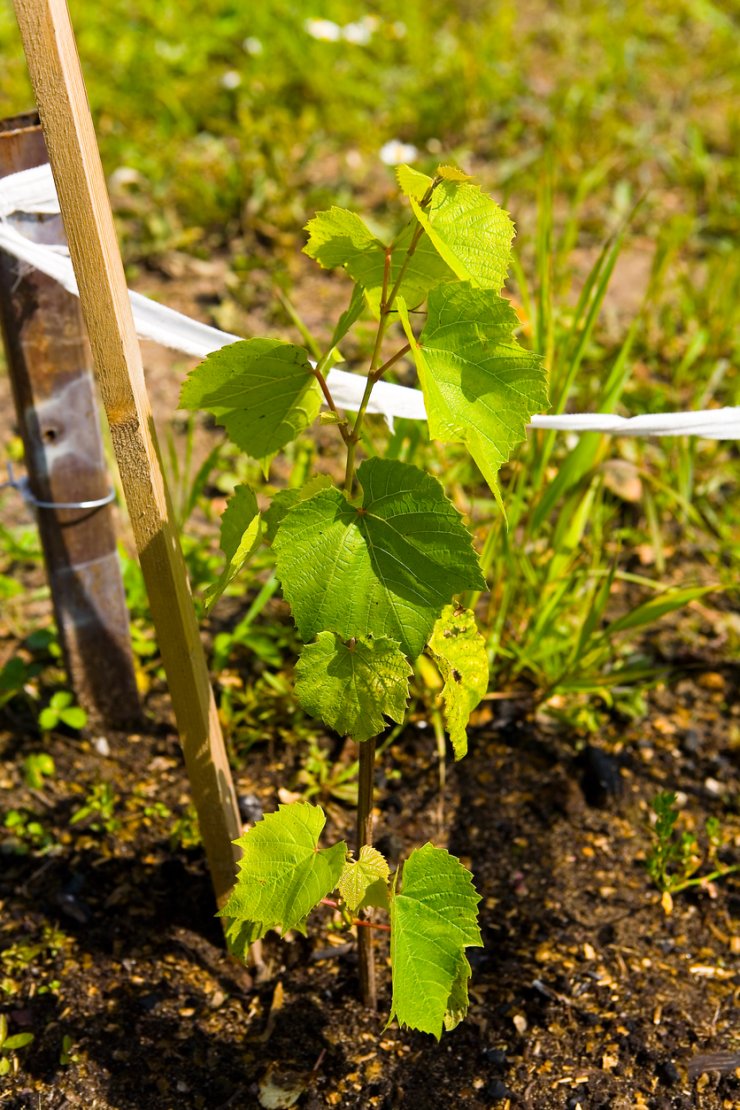
A young grape seedling, planted.
Plant in early spring, whether it’s a cutting or a seedling or bare-root/potted vine. Before planting bare-root stock, trim the roots to 6 to 12 inches to encourage feeder roots to grow near the trunk, and soak them in water for an hour or two before planting.
Be ready to get your vines into the ground within 48 hours, so they don’t break dormancy!
In order to give your vines a great start, begin by working the soil and removing weeds, roots, and rocks. Dig a hole that’s large enough to spread out the roots, at least 12 inches deep and wide, and remove all the sprouts (called canes) except the most vigorous one. Cut this back to just two buds.
Keep the topsoil from your hole in a separate pile to be used at the bottom of the hole over the roots. Mix dehydrated cow manure, garden compost, or sphagnum/granular peat moss into your pile of topsoil to loosen it.
Set the vine into the hole slightly deeper than it grew in the nursery, with the lowest bud on the cane just above the soil surface. Spread out the root system and cover the roots with 4 to 6 inches of topsoil, which should then be tamped down. Fill the hole with remaining soil, but don’t tamp this down. Water well.
- Tip: Don’t mulch your grapevine. Mulching keeps the roots too cool for healthy growth. Remember, grapes love the sun.
You may want to apply a small amount of fertilizer two weeks after planting. Consider applying 2 ounces of 33-0-0 to the plants, making sure it’s applied at least 1 foot away from the vine.
Train each vine to a separate stake or to an upright post on a fence, trellis, or arbor in the first summer. Pinch back all side shoots that grow to two leaves each. Allow the trunk of the vine to grow to the top of the post in the first year, securing it to the post as it grows.
If you’re unclear on how this works, picture the vineyards you’ve seen in photos or even in person. The trunk of the vine grows up a stake, post, or vertical part of a trellis, fence, or arbor. Then the sprouts (canes) will be trained to grow along wires or horizontal members of the supporting structure.
Just make sure the structure you’re using to support your vine is sturdy. Grapevines grow quickly and can get quite heavy, and you don’t want to have to rebuild it later on!
The best part about grapevines is that you can train them into pretty much any shape you want, as long as you have sturdy vertical and horizontal supports.
Meanwhile, after shoot growth begins, remove all but the two strongest shoots in that first summer, including removing shoots that come out of the ground. Keep vines watered and weeded, and remove all flower clusters in the first year. This channels the plant’s energy into building a strong root system.
Do you have grapes on a fence, trellis, or arbor—or have you chosen the stake method? Please share your grape-planting experiences with us in the comments.


 Previous
Previous

